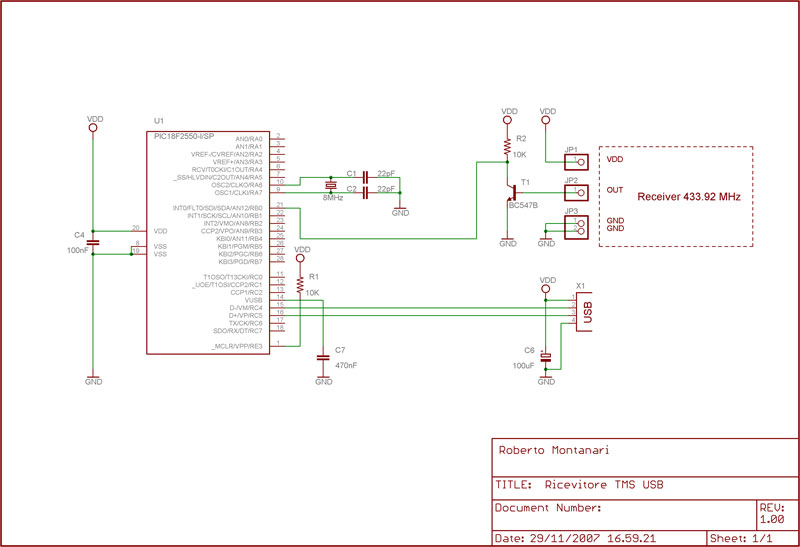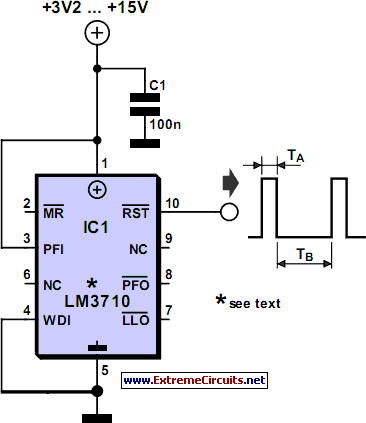
monitor an input pulse train

This circuit functions as a missing pulse detector, utilized in the General Purpose Controller Board with Basic Stamp 1. It monitors an input pulse train, and when a pulse is missed, the output of the 555 timer switches to a low state. In this application, input pulses are generated from an infrared (IR) sensor repurposed from an old VCR. An "All In One Remote" is employed to continuously trigger the IR sensor by pressing and holding one of its buttons, resulting in continuous transmission. When the IR beam is interrupted by an object or person passing by, the missing pulse circuit generates an output signal to the Basic Stamp. The resistor R2 requires adjustment based on the specific button being used on the remote.
The missing pulse detector circuit is primarily based on the 555 timer IC configured in a monostable mode. In this configuration, the 555 timer generates a single output pulse when triggered by an input signal. The circuit continuously monitors the input pulse train from the IR sensor, which is activated by the remote control. The IR sensor outputs a series of pulses as long as the IR beam is uninterrupted.
When the IR beam is obstructed, indicating a missed pulse, the 555 timer's output transitions from a high state to a low state. This transition serves as a notification to the Basic Stamp microcontroller, which can then execute a predetermined response based on the missing pulse event. The circuit's design includes a resistor (R2) that must be calibrated to account for variations in the remote control buttons, ensuring reliable detection of pulse interruptions.
Incorporating additional components such as capacitors may enhance the circuit's stability and response time. The specific values of the resistors and capacitors can be calculated based on the desired timing characteristics of the pulse detection. Additionally, a diode may be included to protect the circuit from reverse polarity or voltage spikes that could occur from the IR sensor's output.
Overall, the missing pulse detector is a valuable component for applications requiring real-time monitoring of pulse signals, allowing for responsive actions when interruptions occur. This circuit exemplifies the integration of traditional electronic components in modern applications, showcasing the versatility and functionality of the 555 timer IC in pulse detection scenarios.This circuit is a missing pulse detector. It is used in the_ General Purpose Controller Board with Basic Stamp 1. This circuit is used to monitor an input pulse train, and when a pulse is missed the 555 timer output will switch low. For the General Purpose Controller Board the input pulses are provided from an IR sensor salvaged from an old VCR.
A n "All In One Remote" is used to trigger the IR sensor continuously by clamping one of the remote buttons down, which causes the remote to transmit continuously. When the IR beam is broken by someone walking past it the missing pulse circuit produces an output to the Basic Stamp.
R2 must be adjusted differently for different buttons on the remote. 🔗 External reference
The missing pulse detector circuit is primarily based on the 555 timer IC configured in a monostable mode. In this configuration, the 555 timer generates a single output pulse when triggered by an input signal. The circuit continuously monitors the input pulse train from the IR sensor, which is activated by the remote control. The IR sensor outputs a series of pulses as long as the IR beam is uninterrupted.
When the IR beam is obstructed, indicating a missed pulse, the 555 timer's output transitions from a high state to a low state. This transition serves as a notification to the Basic Stamp microcontroller, which can then execute a predetermined response based on the missing pulse event. The circuit's design includes a resistor (R2) that must be calibrated to account for variations in the remote control buttons, ensuring reliable detection of pulse interruptions.
Incorporating additional components such as capacitors may enhance the circuit's stability and response time. The specific values of the resistors and capacitors can be calculated based on the desired timing characteristics of the pulse detection. Additionally, a diode may be included to protect the circuit from reverse polarity or voltage spikes that could occur from the IR sensor's output.
Overall, the missing pulse detector is a valuable component for applications requiring real-time monitoring of pulse signals, allowing for responsive actions when interruptions occur. This circuit exemplifies the integration of traditional electronic components in modern applications, showcasing the versatility and functionality of the 555 timer IC in pulse detection scenarios.This circuit is a missing pulse detector. It is used in the_ General Purpose Controller Board with Basic Stamp 1. This circuit is used to monitor an input pulse train, and when a pulse is missed the 555 timer output will switch low. For the General Purpose Controller Board the input pulses are provided from an IR sensor salvaged from an old VCR.
A n "All In One Remote" is used to trigger the IR sensor continuously by clamping one of the remote buttons down, which causes the remote to transmit continuously. When the IR beam is broken by someone walking past it the missing pulse circuit produces an output to the Basic Stamp.
R2 must be adjusted differently for different buttons on the remote. 🔗 External reference





